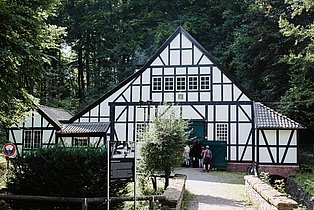
Opening hours
Forging demonstrations 1st Sunday of the month from 2 to 6 pm (April to October).
Admission is free.
The Halbachhammer is a donation by Gustav Krupp von Bohlen und Halbach to the city of Essen. Originally located in Weidenau an der Sieg, the monument is now situated in the western Waldpark, which Margarethe Krupp had built as a permanent facility with the construction of the Margarethenhöhe garden suburb and donated to the city of Essen as a "promenade donation" for local recreational purposes.
First mentioned in a document around 1417, after 500 years of active operation it was the last facility of its kind in the Siegerland region to be shut down around 1900. Gustav Krupp von Bohlen und Halbach arranged for its transfer to Essen and had it rebuilt ready for operation in 1935/36 in the Nachtigallental valley - within sight of the Margarethenhöhe.
Today, the Margarethenhöhe, the surrounding woods and the Halbachhammer form a private foundation complex of the highest cultural value. In terms of technical history, the Halbachhammer represents a "hammer mill". Based on water power and charcoal, this combined an interrelated smelting and forging process under one roof. The purpose of the plant was to produce "wrought iron", i.e. steel, from carbon-enriched and brittle pig iron by means of a renewed smelting ("refining") and forging process. Throughout Europe, the Halbachhammer is one of the extremely rare monuments representing this pre-industrial steelmaking technique. In the wake of extensive restoration work, the heavy upheaval hammer was submerged in November 2010 for the first time since the 1930s.
The Halbachhammer field office is closed during the winter months.
In the future, the Halbachhammer will be a station on the "Water Route" in connection with the project "Essen. New Ways to Water" project, the Halbachhammer will be a station on the "Water Route", one of three adventure routes currently under construction that will connect the Ruhr Valley with the New Emscher Valley via networked green corridors.
How and with what you can best get to us and our locations, you can find out here.